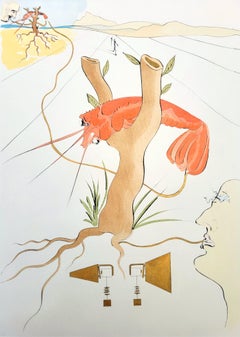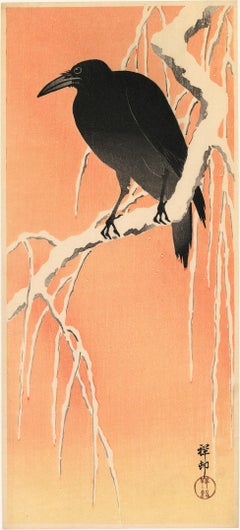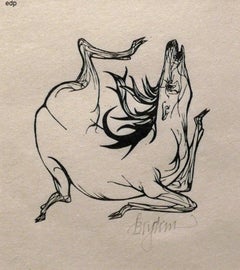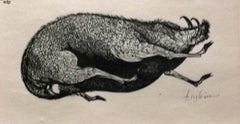Leonard Baskin Animal Prints
American, 1922-2000
LEONARD BASKIN
Born 1922, New Jersey; died 2000.
Leonard Baskin was born the son of a Rabbi. He was educated in art at the New School for Social Research in New York City and at Yale University.
Baskin regarded himself primarily as a sculptor, though he also excelled in printmaking, watercolor, and painting. The artist's mostly figurative work was at odds with much of the art making of his generation, but it nonetheless earned an impressive following.
Baskin is widely regarded as one of the foremost American sculptors of the twentieth century. Boldly embracing political and social issues, he made art that he felt could affect individuals profoundly at both a personal and archetypal level. He also ran a printing press, and his artist books are considered some of the most impressive in the medium.
Baskin's sculptures, books, and works on paper are found in most serious and important public and private collections in the world including the Amon Carter Museum, Fort Worth, The Hirshhorn Museum and Sculpture Garden, Washington, D.C., and The Museum of Modern Art, New York.to
2
1
1
Overall Width
to
Overall Height
to
2
2
50
194
161
118
94
4
1
1
2
1
1
2
2
2
1
1
3
1
1
1
1
2
2
4
Artist: Leonard Baskin
The Owl that calls upon the Night speaks the Unbeliever's ...
By Leonard Baskin
Located in San Francisco, CA
This artwork titled "The Owl that calls upon the Night speaks the Unbeliever's" 1968 is an original woodcut on Makuroko paper by noted American artist Leonard Baskin, 1922-2000. It i...
Category
Mid-20th Century American Modern Leonard Baskin Animal Prints
Materials
Woodcut
Stag
By Leonard Baskin
Located in San Francisco, CA
This artwork titled "Stag" 1957 is an original woodcut on laid paper by noted American artist Leonard Baskin, 1922-2000. It is hand signed and inscribed A.P. (Artist Proof) pencil by...
Category
Mid-20th Century American Modern Leonard Baskin Animal Prints
Materials
Woodcut
French Prawn, Woodcut Print on Rice Paper by Leonard Baskin
By Leonard Baskin
Located in Long Island City, NY
This woodcut print was created by American artist Leonard Baskin. Baskin is well known for his somewhat grotesque, intricate, surreal drawings and natural subject matter. This print ...
Category
1950s Surrealist Leonard Baskin Animal Prints
Materials
Rice Paper, Woodcut
Warthog, Drypoint Etching by Leonard Baskin, 1969
By Leonard Baskin
Located in Long Island City, NY
This drypoint etching was created by American artist Leonard Baskin. Baskin is well known for his somewhat grotesque, intricate, surreal drawings and natural subject matter. This etc...
Category
1970s Surrealist Leonard Baskin Animal Prints
Materials
Drypoint, Etching
Related Items
Le Téléphone (Lobster Telephone) /// Salvador Dali Surrealism Modern Engraving
By Salvador Dalí
Located in Saint Augustine, FL
Artist: Salvador Dali (Spanish, 1904-1989)
Title: "Le Téléphone (Lobster Telephone)"
Portfolio: Hommage à Leonardo da Vinci (Great Inventions)
*Signe...
Category
1970s Surrealist Leonard Baskin Animal Prints
Materials
Engraving, Etching, Intaglio
$8,500
H 29.25 in W 22.38 in
Crow on a Snowy Willow Branch with Orange Sky
By Ohara Koson
Located in Burbank, CA
A crow perches on a snow-covered willow branch, the bright orange sky that indicates dawn creating a bold contrast. Corvus corone (the carrion crow) is a commonly seen bird in Japan,...
Category
1920s Showa Leonard Baskin Animal Prints
Materials
Mulberry Paper, Woodcut
François Xavier Lalanne, bird on lillies, 2006
By François-Xavier Lalanne
Located in Saint Ouen, FR
Natural history - François-Xavier Lalanne
Etching
Numbered out of 70 and signed F.X.L. in pencil
Robert and Lydie Dutrou editors 2006.
Paper size: 40x33cm
Work size: 16x19.5cm
Category
Early 2000s Surrealist Leonard Baskin Animal Prints
Materials
Paper
$2,471
H 15.75 in W 13 in D 0.4 in
Original 1919, Give the World The Once Over in the United States Navy poster
Located in Spokane, WA
Original 1919 Give The World The Once Over in the United States Navy vintage poster. Archival linen backed. This poster presents itself very fine condition. The lower text por...
Category
1910s American Modern Leonard Baskin Animal Prints
Materials
Lithograph
$2,998
H 42 in W 28.5 in D 0.05 in
Tigre couché à l'entrée de son antre (Tiger Lying at the Entrance to its Lair)
By Eugène Delacroix
Located in Middletown, NY
Etching, drypoint, and roulette on watermarked Hallines cream laid paper, 3 3/4 x 5 7/8 inches (95 x 148 mm), full margins. A very good impression of this charming image, with all of...
Category
Early 19th Century Realist Leonard Baskin Animal Prints
Materials
Laid Paper, Drypoint, Etching
Black Horse
By Tokuriki Tomikichiro
Located in Middletown, NY
circa 1950.
Woodblock print in black and gray ink on Japon laid paper, 10 1/4 x 15 3/4 inches (260 x 398 mm), full margins. With the artist's embossed chop mark in red ink in the l...
Category
Mid-20th Century Edo Leonard Baskin Animal Prints
Materials
Handmade Paper, Woodcut
Salvador Dali, Le Cerf Malade Signed Etching Engraving, Color Lithograph Pochoir
By Salvador Dalí
Located in Surfside, FL
An original signed drypoint etching with color pochoir by Spanish artist Salvador Dali titled "La Cerf Malade", depicting a stag deer, from the Portfolio: Le Bestiaire de la Fontaine...
Category
1970s Surrealist Leonard Baskin Animal Prints
Materials
Color, Drypoint, Etching
$3,600
H 35.5 in W 27.75 in
Alexander Calder Circus Reproduction Lithograph After a Drawing
By (after) Alexander Calder
Located in Surfside, FL
(after) Alexander Calder
"Calder's Circus" offset lithograph on wove paper after drawings by the artist
Published by Art in America and Perls gallery in 1964 (from drawings done in the 1930's)
these range slightly in size but they are all about 13 X 17 inches (with minor variations in size as issued.) These have never been framed. The outer folio is not included just the one lithograph.
James Sweeny from the introduction “The fame of Calder’s circus spread quickly between the years 1927 and 1930. All the Paris art world came to know it. It brought him his first great personal success. But what was more important, the circus also provided the first steps in Calder’s development as an original sculptor”
Clive Gray wrote ”A visit to the studio of Alexander Calder led to the chance discovery of some hundred masterful circus drawings completed over thirty years ago. We publish, for the first time, a choice of sixteen from that group.” With signed introduction by Miro.
These whimsical drawings, done in the style of wire sculpture, include acrobats, clowns, jugglers, trapeeze artists, an elephant, dog and lion. they are great.
Alexander Calder is widely considered to be one of the most important American sculptors of the 20th century. He is best known for his colorful, whimsical abstract public sculptures and his innovative mobiles, kinetic sculptures powered by motors or air currents, which embraced chance in their aesthetic. Born into a family of accomplished artists, Calder's work first gained attention in Paris in the 1930s and was soon championed by the Museum of Modern Art in New York, resulting in a retrospective exhibition in 1943. Major retrospectives were also held at the Solomon R. Guggenheim Museum (1964) and the Museum of Contemporary Art, Chicago (1974). Calder’s work is in many permanent collections, most notably in the Whitney Museum of American Art, but also the Guggenheim Museum; the Museum of Modern Art; the National Gallery of Art, Washington, D.C.; and the Centre Georges Pompidou. He produced many large public works, including .125 (at JFK Airport, 1957), Pittsburgh (Carnegie International prize winner 1958, Pittsburgh International Airport) Spirale (UNESCO in Paris, 1958), Flamingo and Universe (both in Chicago, 1974), and Mountains and Clouds (Hart Senate Office Building, Washington, D.C., 1976). Although primarily known for his sculpture, Calder was a prodigious artist with a restless creative spirit, whose diverse practice included painting and printmaking, miniatures (such as his famous Cirque Calder), children’s book illustrations, theater set design, jewelry design, tapestry and rug works, and political posters. Calder was honored by the US Postal Service with a set of five 32-cent stamps in 1998, and received the Presidential Medal of Freedom, posthumously in 1977, after refusing to receive it from Gerald Ford one year earlier in protest of the Vietnam War.
Calder moved to New York and enrolled at the Art Students League, studying briefly with Thomas Hart Benton, George Luks, Kenneth Hayes Miller, and John Sloan. While a student, he worked for the National Police Gazette where, in 1925, one of his assignments was sketching the Ringling Bros. and Barnum & Bailey Circus. Calder became fascinated with the action of the circus, a theme that would reappear in his later work.
In 1926, Calder moved to Paris, enrolled in the Académie de la Grande Chaumière, and established a studio at 22 rue Daguerre in the Montparnasse Quarter. In June 1929, while traveling by boat from Paris to New York, Calder met his future wife, Louisa James (1905-1996), grandniece of author Henry James and philosopher William James. They married in 1931. While in Paris, Calder met and became friends with a number of avant-garde artists, including Fernand Léger, Jean Arp, and Marcel Duchamp. Cirque Calder (on view at the Whitney Museum of American Art at present) became popular with the Parisian avant-garde. He also invented wire sculpture, or "drawing in space," and in 1929 he had his first solo show of these sculptures in Paris at Galerie Billiet. Hi! (Two Acrobats) in the collection of the Honolulu Museum of Art is an early example of the artist's wire sculpture. The painter Jules Pascin, a friend of Calder's from the cafes of Montparnasse, wrote the preface to the catalog. A visit to Piet Mondrian's studio in 1930, where he was impressed by the environment-as-installation, "shocked" him into fully embracing abstract art, toward which he had already been tending.
Dating from 1931, Calder’s sculptures of discrete movable parts powered by motors were christened “mobiles” by Marcel Duchamp, a French pun meaning both "motion" and "motive." At the same time, Calder was also experimenting with self-supporting, static, abstract sculptures, dubbed "stabiles" by Jean Arp in 1932 to differentiate them from mobiles.
Public commissions increasingly came his way in the 1960s. Notable examples are .125 for JFK Airport in 1957, Spirale for UNESCO in Paris 1958 and Trois disques, commissioned for Expo 67 in Montreal, Quebec, Canada. Calder's largest sculpture at 25.7 meters high was El Sol Rojo, constructed outside the Aztec Stadium for the 1968 Summer Olympics "Cultural Olympiad" events in Mexico City. Many of his public works were commissioned by renowned architects; I.M. Pei commissioned his La Grande Voile (1966), a 25-ton, 40-foot high stabile for the Massachusetts Institute of Technology.
Part of Calder's repertoire includes pivotal stage sets for more than a dozen theatrical productions, including Nucléa, Horizon, and most notably, Martha Graham’s Panorama (1935), a production of the Erik Satie symphonic drama Socrate (1936), and later, Works in Progress (1968).
In addition to sculptures, Calder painted throughout his career, beginning in the early 1920s. He picked up his study of printmaking in 1925, and continued to produce illustrations for books and journals.As Calder’s professional reputation expanded in the late 1940s and 1950s, so did his production of prints. Masses of lithographs based on his gouache paintings hit the market, and deluxe editions of plays, poems, and short stories illustrated with fine art prints by Calder became available for sale.
One of Calder's most celebrated and unconventional undertakings was a commission from Dallas-based Braniff International Airways to paint a full-size Douglas DC-8-62 four-engined jet as a "flying canvas."
Calder created over 2,000 pieces of jewelry over the course of his career, many of them as gifts for friends and relatives. For his lifelong friend Joan Miró, he set a shard of a broken porcelain vessel in a brass ring. Peggy Guggenheim received enormous silver mobile earrings and later commissioned a hammered silver headboard...
Category
1930s American Modern Leonard Baskin Animal Prints
Materials
Lithograph
Leonor Fini, Sphinx Ariene, rare handsigned print
By Leonor Fini
Located in Saint Ouen, FR
Rare print handsigned and numered by surrealist artist Leonor Fini, now rediscovered and inscreasingly esteemed with the movement of rediscovering art by women. It depicts a mytholog...
Category
20th Century Surrealist Leonard Baskin Animal Prints
Materials
Paper
$3,413
H 0.08 in W 27.56 in D 20.08 in
Francois-Xavier Lalanne (1927-2008) Les Spitz, 2004
By François-Xavier Lalanne
Located in Saint Ouen, FR
Francois-Xavier Lalanne (1927-2008) Les Spitz, 2004
Original print (etching) hand signed in pencil by François Xavier Lalanne and untitled "Les Spitz" ("The Spitz"), in perfect cond...
Category
Early 2000s Surrealist Leonard Baskin Animal Prints
Materials
Paper
$3,766
H 15.36 in W 11.42 in D 0.4 in
"The Fish" Ida Ten Eyck O'Keeffe, Trout, Black and White, Water, Animal Art
Located in New York, NY
Ida Ten Eyck O'Keeffe
The Fish, 1935
Signed and dated in pencil lower right
Monotype on paper
Image 6 x 8 1/2 inches
Exhibited
Dallas Museum of Art, Ida O'Keeffe: Escaping Georgia's...
Category
1930s American Modern Leonard Baskin Animal Prints
Materials
Paper, Monotype
"Echoes of Return" Photography 41" x 28" in Edition 1/3 by Olha Stepanian
By Olha Stepanian
Located in Culver City, CA
"Echoes of Return" Photography 41" x 28" in Edition 1/3 by Olha Stepanian
Printed on Epson Professional Paper
Signed and numbered by the artist
Not framed. Ships in a tube.
Avai...
Category
21st Century and Contemporary Surrealist Leonard Baskin Animal Prints
Materials
Photographic Paper
$2,350
H 41 in W 28 in D 0.1 in
Previously Available Items
BOAR
By Leonard Baskin
Located in Portland, ME
Baskin, Leonard. STAG. FO'S 306. Wood Engraving, 1957. Illustration for Flaubert's St. Julien the Hospitaller. 3 1/4 x 3 1/8 inches, 82 x 77 mm. In excellent condition.
Category
1950s Leonard Baskin Animal Prints
Materials
Woodcut
BOAR
By Leonard Baskin
Located in Portland, ME
Baskin, Leonard. BOAR. FO'S 304. Wood Engraving, 1957. Illustration for Flaubert's St. Julien the Hospitaller. 2 5/8 x 5 3/4 inches, 67 x 147 mm. (image) on a larger sheet. In excell...
Category
1950s Leonard Baskin Animal Prints
Materials
Woodcut
Icarus, Lithograph, 1969
By Leonard Baskin
Located in Long Island City, NY
This lithograph was created by American artist Leonard Baskin. Baskin is well known for his somewhat grotesque, intricate, surreal drawings and natural subject matter. This lithograp...
Category
1960s Surrealist Leonard Baskin Animal Prints
Materials
Lithograph
Icarus, Lithograph, 1969
By Leonard Baskin
Located in Long Island City, NY
This lithograph was created by American artist Leonard Baskin. Baskin is well known for his somewhat grotesque, intricate, surreal drawings and natural subject matter. This lithograp...
Category
1960s Surrealist Leonard Baskin Animal Prints
Materials
Lithograph
Leonard Baskin animal prints for sale on 1stDibs.
Find a wide variety of authentic Leonard Baskin animal prints available for sale on 1stDibs. You can also browse by medium to find art by Leonard Baskin in drypoint, engraving, etching and more. Much of the original work by this artist or collective was created during the 20th century and is mostly associated with the Surrealist style. Not every interior allows for large Leonard Baskin animal prints, so small editions measuring 30 inches across are available. Customers who are interested in this artist might also find the work of Nura Ulreich, Leonor Fini, and Yargo De Lucca. Leonard Baskin animal prints prices can differ depending upon medium, time period and other attributes. On 1stDibs, the price for these items starts at $750 and tops out at $1,250, while the average work can sell for $1,000.



